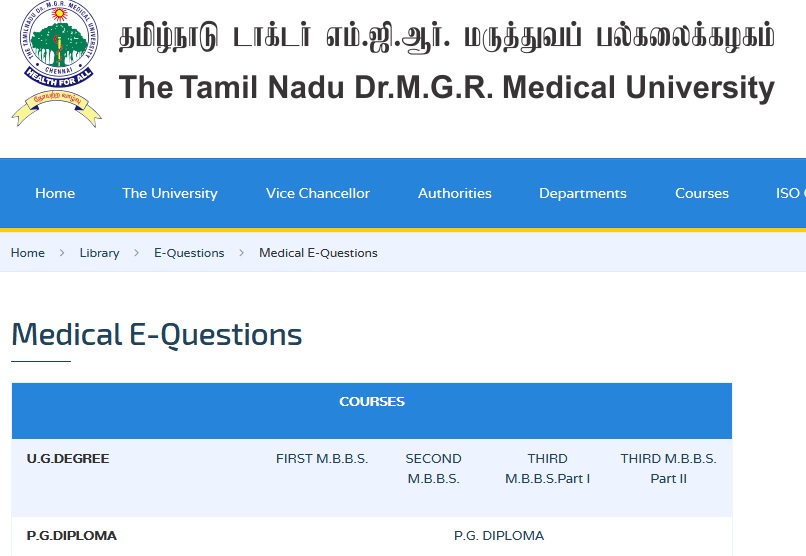Recent Advances in Tuberculosis & Chest Diseases MD Question Bank : web.tnmgrmu.ac.in
Name of the University : The Tamilnadu Dr. M.G.R. Medical University
Degree : Doctor of Medicine (M.D.)
Branch : Branch XVII –Tuberculosis and Respiratory Diseases
Subject Code/Name : 2064/Recent Advances In Tuberculosis And Chest Diseases
Paper : IV
Document Type : Question Bank
Website : web.tnmgrmu.ac.in
Download Model/Sample Question Paper :
1990-2000 : https://www.pdfquestion.in/uploads/web.tnmgrmu.ac.in/4333-1-202064KC.pdf
2001-2014 : https://www.pdfquestion.in/uploads/web.tnmgrmu.ac.in/4333-2-202064KX.pdf
TNMGRMU Tuberculosis & Chest Diseases Question Paper
Sub. Code: 2064
M.D. DEGREE EXAMINATION
Branch XVII –Tuberculosis and Respiratory Diseases
RECENT ADVANCES IN TUBERCULOSIS AND CHEST DISEASES
Common to
Part II – Paper III – (Old /New/Revised Regulations)
(Candidates admitted upto 2003-04) and
Paper IV – (For candidates admitted from 2004-2005 onwards)
Related : Tamilnadu Dr. M.G.R. Medical University Forensic Medicine Including Physical Anthropology & Forensic Odontology MD Question Bank : www.pdfquestion.in/4304.html
September 2008
Q.P. Code : 202064
Time : Three hours
Maximum : 100 marks
Draw suitable diagram wherever necessary. :
Answer ALL questions. :
I. Essay questions : (2 X 20 = 40)
1. Classify the mediastinal tumors. Discuss the various investigation with emphasis on mediastinoscopy.
2. Discuss the various modes of weaning from ventilator.
II. Write short notes on : (10 X 6 = 60)
1. Endobronchial ultrasound.
2. Exercise induced asthma.
3. Dynamic stents.
4. Pulmonary rehabilitation.
5. BOOP.
6. Lipoid pneumonitis.
7. Humidifier fever.
8. Melioidosis.
9. Hoover’s sign.
10. Chemical Planodesis.

March 2009
I. Essay questions : (2 x 20 = 40)
1. Discuss the clinical features and management of obstructive sleep apnoea.
2. Describe the clinical features, diagnosis and management of pulmonary thromboembolism.
II. Write short notes on : (10 x 6 = 60)
1. Smoking cessation.
2. Vanishing lung syndrome.
3. Scar carcinoma.
4. Berylliosis.
5. Lung transplantation.
6. Fluticasone.
7. Autoflourescent bronchoscopy.
8. Bronchial provocation test.
9. Eosinophilic bronchitis.
10. Heimlich valve.
September 2009
[KV 170] Sub. Code: 2064
I. Essay questions : (2 x 20 = 40)
1. What is ARDS? Discuss the ventilatory strategies in ARDS.
2. Describe XDR TB. How will you approach a case of Category II failure? How will you ensure community participation in TB control?
II. Write short notes on : (10 x 6 = 60)
1. Syndrome Z.
2. Targetted therapy in Lung cancer.
3. Endoscopic LVRS.
4. Diagnostic methods in LTBI.
5. Auto CPAP.
6. MODS.
7. Laser in pulmonary medicine.
8. Medical thoracoscopy.
9. Varenicline.
10. Role of steroids in COPD.
May 2011
Sub. Code: 2064
I. Essay questions : (2 X 20 = 40)
1. Discuss sleep related breathing disorders. Describe the clinical features, diagnosis and treatment of Obstructive sleep Apnoea.
2. Define ARDS. Discuss the etiopathogenesis, clinical features and the ventilatory strategies in ARDS.
II. Write short notes on : (10 X 6 = 60)
1. Lung transplantation.
2. Prevention of Pneumonia.
3. Capnography.
4. Lung expansion therapy.
5. Oxygen delivery system.
6. Laser in pulmonary medicine.
7. Passive smoking.
8. Bronchial artery embolization.
9. Early detection of lung cancer.
10. Surfactant replacement therapy.
April 2012
Answer ALL questions in the same order.
I. Elaborate on :
1. Describe the pathophysiology , clinical features and management of Allergic Bronchio pulmonary Aspergillosis. 16 3515
2. Briefly describe lung transplantation and managementof its complications. 16 35 15
II. Write notes on :
1. Symptoms and consequences of sleep Apnoea. 4 10 7
2. Procedure involved in open lung Biopsy. 4 10 7
3. Hospital Acquired Pneumonia- management. 4 10 7
4. Describe the mediastinal components and its contents. 4 10 7
5. Weaning of patient from ventilator. 4 107
6. Pathogenesis, clinical features and treatment of Bronchogenic cyst. 4 10 7
7. Diagnosis and treatment of Pneumocystis carini pneumonia. 4 10 7
8. Clinical significance of Caplan syndrome. 4 10 7
9. Differences between the lung sequestration and their diagnosis. 4 10 7
10. Clinical features and treatment of Carcinoid tumor. 4 10 7
April 2013
I. Elaborate on: (2×15=30)
1. Discuss the classification, clinical features, diagnosis and management of Interstitial Lung Diseases.
2. Discuss the clinical features, diagnosis, staging and management of Asthma.
II. Write notes on: (10×7=70)
1. Oxygen toxicity
2. Chloro-Fluoro-Carbon
3. Serum markers of Lung Cancer
4. Byssinosis
5. Mesothelioma
6. Usefulness of Computerised Tomogram in Lung Disease
7. Drug-interaction in HIV and Tuberculosis therapy
8. Kartagener’s Syndrome
9. Pleuroscopy
10. Pre-operative evaluation of Lung Function.
April 2014
Q.P.Code: 202063
Time: Three Hours
Maximum: 100 marks
I. Elaborate on: (2X15=30)
1. Pulmonary Aspergillosis.
2. Para-pneumonic Effusion & Management.
II. Write notes on: (10X7=70)
1. Occupational Asthma.
2. Bagpipe Sign.
3. Rheumatoid Pleural Effusion.
4. Pulmonary Alveolar Proteinosis.
5. Pulmonary Amoebiasis.
6. Immotile Cilia Syndrome.
7. Respiratory Manifestations in Systemic Lupus Erythematosis (SLE).
8. Re-breathable mask.
9. Role of Fibreoptic Bronchoscopy (FOB) in Intensive Care Unit (ICU).
10. Hemothorax.